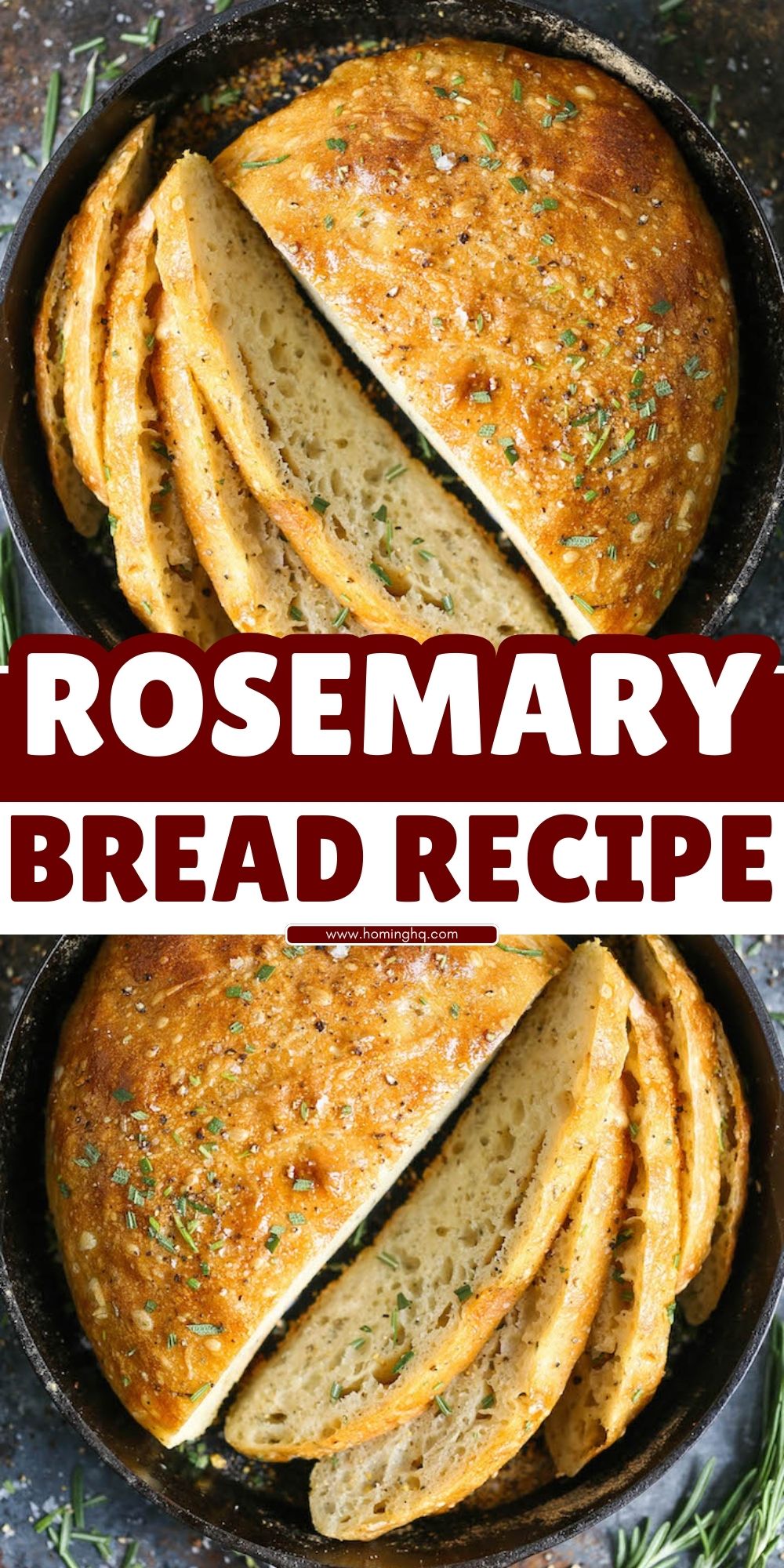All products are selected by our editorial team for quality. If you buy through our links, we may earn a small commission at no extra cost to you.
Rosemary bread is a flavorful and aromatic bread that incorporates the fresh, piney scent and taste of rosemary into its soft, airy texture.
This bread is a favorite for many due to its versatility and unique taste, which elevates it from a simple loaf to something special.
Whether served warm with olive oil or used to complement hearty dishes, rosemary bread can be the star of any meal.
The herb adds depth to the flavor, making it perfect for gatherings, holiday meals, or as a side to your favorite pasta.

What is Rosemary Bread?
Rosemary bread is a type of artisan bread that is infused with fresh or dried rosemary.
The combination of rosemary’s distinct flavor with a simple bread dough creates a fragrant, savory loaf.
It is typically soft with a slightly crisp crust, and the rosemary is either kneaded into the dough or sprinkled on top before baking.
The bread has a rustic charm that makes it perfect for both casual dinners and festive occasions.
While it’s often served as a side dish, its hearty flavor makes it suitable for pairing with soups, salads, and even as a base for sandwiches.
The infusion of rosemary makes each bite flavorful and aromatic, offering a perfect balance between herbaceous and comforting bread.
Key Ingredients for Rosemary Bread
To make rosemary bread, you will need a few essential ingredients that come together to create a light, flavorful loaf.
Flour is the base of any bread, providing structure and texture.
For this recipe, all-purpose flour works perfectly, but you can experiment with whole wheat flour for a denser, heartier loaf.
Fresh rosemary is the star ingredient in this bread.
Its fragrant needles are finely chopped and incorporated into the dough, giving the bread its signature flavor.
You can also use dried rosemary if fresh isn’t available, but fresh herbs provide a more vibrant taste.
Yeast is crucial for making the bread rise.
Active dry yeast or instant yeast will both work well in this recipe, helping the dough to expand and become light and airy.
Olive oil adds richness and moisture to the dough.
It also imparts a subtle depth of flavor that complements the rosemary.
Salt and sugar are basic seasonings that balance out the taste.
The salt enhances the bread’s flavor, while a touch of sugar helps activate the yeast, leading to a better rise.
Finally, water is needed to hydrate the dry ingredients and bring the dough together.
The temperature of the water should be warm to ensure the yeast activates properly.
Step-by-Step Guide to Making Rosemary Bread

Step 1: Prepare the Dough
Begin by mixing warm water with a little sugar. Stir to dissolve the sugar, then sprinkle in the yeast.
Let this sit for about 5-10 minutes until it becomes frothy. In a separate bowl, combine the flour and salt.
Once the yeast mixture is ready, pour it into the flour mixture and stir to combine.
Step 2: Knead the Dough
Transfer the dough onto a clean surface and begin kneading.
Use your hands to fold the dough in on itself, pushing it away with the heels of your hands and then folding it over.
Continue kneading for about 8-10 minutes, until the dough becomes smooth and elastic.
If the dough feels too sticky, sprinkle a little more flour as you knead, but be careful not to add too much.
Step 3: First Proofing
Once the dough is kneaded, form it into a ball and place it in a lightly oiled bowl.
Cover the bowl with a damp cloth or plastic wrap.
Leave the dough to rise for about 1-1.5 hours, or until it has doubled in size.
The warmth in the room and the yeast will help it expand.
Step 4: Shape the Dough
Once the dough has risen, gently punch it down to release the air.
Transfer the dough onto a floured surface and shape it into your desired form—either a round boule or a long loaf.
Be gentle with the dough to retain the airy texture created during proofing.
Step 5: Second Proofing
Place the shaped dough onto a baking sheet lined with parchment paper.
Cover it again with a cloth and let it rise for an additional 30-60 minutes, or until it has puffed up and is nearly doubled in size.
This second proofing allows the bread to develop a lighter texture.
Step 6: Preheat the Oven
While the dough is in its second rise, preheat your oven to 375°F (190°C).
A well-heated oven ensures a nice rise and a crispy, golden crust.
Step 7: Bake the Bread
Once the dough is ready and the oven is preheated, bake the bread for 25-30 minutes, or until the top is golden brown.
To test for doneness, tap the bottom of the loaf—if it sounds hollow, the bread is fully baked.
Step 8: Cooling the Bread
After removing the bread from the oven, let it cool on a wire rack.
Cooling the bread allows the steam to escape and the texture to set properly.
Slicing it too soon may result in a gummy texture.
Tips for Perfecting Your Rosemary Bread
To ensure your rosemary bread turns out perfectly every time, consider these helpful tips.
Fresh vs.
Dried Rosemary: While fresh rosemary imparts a brighter, more aromatic flavor, dried rosemary can still be used if fresh isn’t available.
Just remember that dried herbs are more concentrated, so you may want to use a bit less.
Using a Baking Stone or Dutch Oven: For an even crust, consider baking your rosemary bread on a baking stone.
A Dutch oven can also help trap moisture during the baking process, creating a beautifully soft interior and crispy exterior.
Adding Olive Oil: If you want a richer flavor, add a tablespoon or two of olive oil to the dough.
It makes the bread a little more tender and adds a depth of flavor that complements the rosemary.
Proper Storage: Rosemary bread can be stored at room temperature for a few days, but if you want to keep it fresh longer, freeze it.
Wrap it tightly in plastic wrap or foil before placing it in a freezer bag.
Be Mindful of Proofing Times: Proofing is essential for getting a light, airy loaf.
Make sure you allow enough time for both the first and second rises. Under-proofing can result in denser bread.
Experiment with Additional Flavors: For a more complex flavor, try adding garlic or lemon zest to the dough, or sprinkle some sea salt on top before baking.
Serving Suggestions for Rosemary Bread
Rosemary bread is incredibly versatile and pairs well with a variety of dishes.
Serve it alongside soups and stews to soak up the flavorful broths.
Its savory flavor also makes it a perfect accompaniment to fresh salads, providing a hearty contrast to the crisp greens.
For a simple yet satisfying snack, drizzle a little olive oil on top and enjoy it with a sprinkle of sea salt.
Rosemary bread also works wonderfully for sandwiches. The rich flavor of the bread complements meats, cheeses, and vegetables beautifully.
You can slice it and serve it as part of a bread basket at your next dinner party, or use it for making delicious toast topped with butter, jam, or even roasted vegetables.
Conclusion
Rosemary bread is a simple yet flavorful way to elevate your bread-baking skills.
With its distinct aroma and delicious taste, it adds a unique twist to any meal.
Whether you’re serving it as a side dish or using it for sandwiches, rosemary bread is a crowd-pleaser that’s sure to impress.
The step-by-step guide and helpful tips ensure you can bake the perfect loaf every time, and the versatility of this bread allows for countless variations to suit your tastes.
Try it out and enjoy the rustic, savory goodness that rosemary bread brings to the table.
Frequently Asked Questions
- Can I use dried rosemary instead of fresh? Yes, dried rosemary can be used in place of fresh rosemary. However, since dried rosemary is more concentrated, you may want to use slightly less.
- Can I make rosemary bread gluten-free? Yes, you can substitute the all-purpose flour with a gluten-free flour blend. Just keep in mind that the texture may differ, and you might need to adjust the liquid content.
- How do I store rosemary bread? Store rosemary bread at room temperature in an airtight container for up to 3 days. For longer storage, you can freeze it, wrapping it tightly in plastic wrap before placing it in a freezer bag.
- How can I make the bread even more flavorful? You can experiment with adding garlic, lemon zest, or other herbs like thyme or oregano for an even more complex flavor profile. A sprinkle of sea salt on top before baking adds an extra burst of flavor.
- Why is my rosemary bread dense? If your rosemary bread turns out dense, it could be due to under-proofing or overworking the dough. Ensure that you give the dough enough time to rise properly and avoid over-kneading it.

Rosemary Bread
Equipment
- 1 large mixing bowl
- 1 Small Bowl (for yeast mixture)
- 1 clean surface for kneading
- 1 Kitchen Towel or Plastic Wrap
- 1 baking sheet or Dutch oven
- 1 Wire rack (for cooling)
- 1 measuring cup (for water)
- 1 measuring spoons for yeast, salt, and sugar
Ingredients
- 3 cups all-purpose flour
- 1 tablespoon fresh rosemary finely chopped
- 1 teaspoon salt
- 1 teaspoon sugar
- 1 packet active dry yeast 2 ¼ teaspoons
- 1 ¼ cups warm water about 110°F / 43°C
- 1 tablespoon olive oil
Instructions
- Activate the Yeast: In a small bowl, combine the warm water and sugar. Stir until the sugar dissolves. Sprinkle in the yeast and let it sit for 5-10 minutes until it becomes frothy.
- Mix the Dough: In a large bowl, combine the flour, salt, and chopped rosemary. Pour in the yeast mixture and olive oil.Stir to combine until a dough starts to form.
- Knead the Dough: Turn the dough out onto a lightly floured surface. Knead for 8-10 minutes until smooth and elastic. Add a little flour if the dough feels too sticky.
- First Proofing: Form the dough into a ball and place it in a lightly oiled bowl. Cover with a damp towel or plastic wrap and let it rise for about 1-1.5 hours, or until it doubles in size.
- Shape the Dough: Punch the dough down gently to release any air bubbles. Shape it into a round boule or an oval loaf and place it on a baking sheet lined with parchment paper.
- Second Proofing: Cover the dough with a cloth and let it rise for an additional 30-60 minutes, or until it has puffed up.
- Preheat the Oven: While the dough is rising, preheat your oven to 375°F (190°C).
- Bake the Bread: Bake the bread for 25-30 minutes, or until the top is golden brown. To check for doneness, tap the bottom of the loaf—if it sounds hollow, it’s ready.
- Cool the Bread: Let the bread cool on a wire rack before slicing.
Notes
- If you prefer a softer crust, you can cover the bread with foil halfway through the baking time.
- For extra flavor, you can brush the top of the dough with olive oil before baking or sprinkle a pinch of sea salt.
- If you don’t have fresh rosemary, dried rosemary can be used, but you will need to reduce the amount by about half.
- You can freeze rosemary bread for up to 3 months. Wrap it tightly in plastic wrap before freezing.

